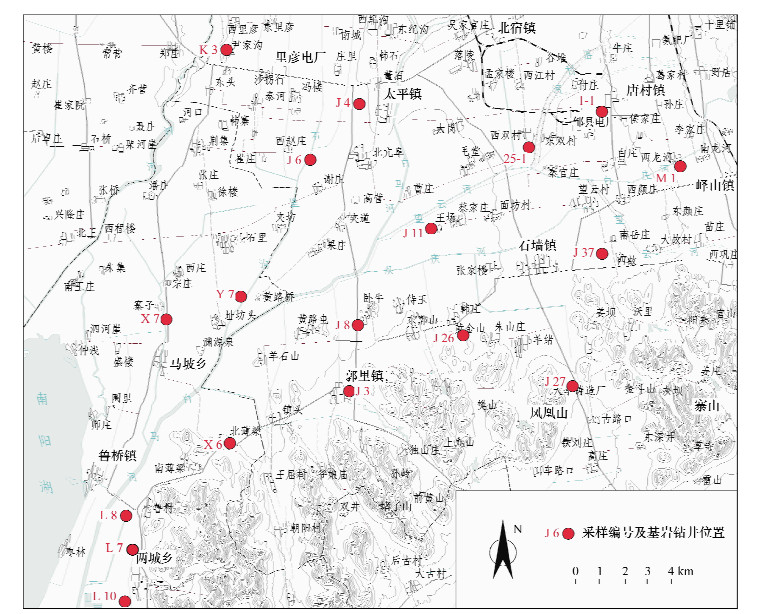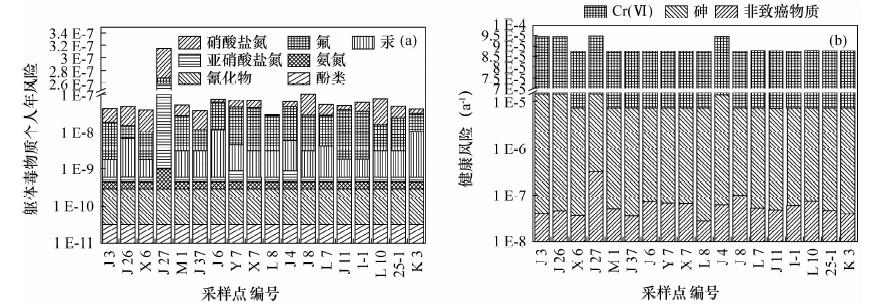Health Risk Assessment of Carcinogenic and Non-carcingenic Substances in Underground Water from the Shuangcun Karst System of Central-Southern Shandong Province
-
摘要: 我国对水质的评价大多局限于各项指标与饮用水源标准的比较, 关注的是超标情况, 而对相关指标对人体健康的影响程度关注甚少。本文运用美国环境保护署的健康风险评价模型, 对鲁中南地区的双村岩溶水系统中2种化学致癌物[As、Cr(Ⅵ)]和7种非致癌物(Hg、F、CN-、NO2--N、NH4+-N、NO3--N、酚类)引起的健康风险作出初步评价。结果表明, 个别采样点的NO3--N、NO2--N含量超过GB5749-2006《生活饮用水卫生标准》限值; 由基因毒物质通过饮水途径所致的个人年健康风险表现为Cr(Ⅵ)>As, 由躯体毒物质通过饮水途径所致的个人年健康风险表现为NO3--N> F> NO2--N> Hg> CN-> NH4+-N>酚类, 且致癌毒物质的危害远远超过非致癌毒物质, Cr(Ⅵ)为首要污染物。研究区地下水的个人健康总风险值介于5.0×10-5~10.0×10-5 a-1之间, 风险等级为Ⅳ级(一般), 其作为饮用水源应给予必要的关注。Abstract: Currently the majority of water quality assessment in China is based on comparison parameters of water with those of drinking water standards.However, to what extent the pollutants influence human health is less known.Herein, Shuangcun karst water samples in central-southern Shandong province were chosen to evaluate human health risk.Using the risk assessment model of USEPA, the risk induced by two carcinogenic substances, such as As, Cr(Ⅵ) and seven non-carcinogenic substances(Hg, F, CN-, NO2--N, NH4+-N, NO3--N, phenols) are evaluated.Results show that concentration of NO3--N and NO2--N in samples from several sites exceeds the limiting value of Hygienic Standard for Drinking Water(GB5749-2006).In terms of annual personal health risk caused by gene toxic substances through water drinking, Cr(Ⅵ) shows greater risk than As.In terms of risk caused by non-gene toxic substances, the induced risk has the sequence of NO3--N> F> NO2--N> Hg> CN-> NH4+-N> phenols.Moreover, the hazard of carcinogenic substances is much stronger than that of non-carcinogenic substances.Cr(Ⅵ) is the primary pollutant.For all the sampling sites, total risk values range from 5.0×10-5 to 10.0×10-5 a-1, and the risk level is Ⅳ(fair).It means that underground water in the sampling area is harmful to human health to some extent.Therefore, it is worth more attention when the studied water serves as the drinking water source.
-
水质不良或水污染可导致多种疾病的发生。据世界卫生组织统计,世界上约80%的疾病是因饮水卫生不良引起的,其中20%的癌症疾病与饮水不良相关[1]。长期以来,我国对水质的评价往往局限于各项指标与饮用水源标准的比较,关注的是超标情况,而对相关指标对人体健康的影响程度关注甚少[2, 3]。当前主要是依据国家标准限值来评价水质是否合格,而健康风险评价较传统的水质等级评价体系更能直观地表征水体中各污染物对人体健康的潜在危害[4, 5, 6]。目前广泛应用的健康风险评价模型是美国科学院研究确立的风险评价基本方法,该模型通过综合污染物危害程度、暴露水平、暴露时间等因素,将水环境污染与人体健康联系起来,以人体健康危害的年风险作为评价因子,使评价指标落实到人体健康上更有现实意义[5, 6, 7, 8]。
我国的健康风险评价工作始于20世纪90年代,最初主要应用于核工业等领域[9, 10, 11],随着水体污染问题越来越严重,关于水环境的健康风险评价也越来越多。段磊等[12]研究了关中盆地浅层地下水中氮污染(NH4+-N、NO2--N、NO3--N)通过饮水途径对人体产生的潜在风险,研究表明在浅层地下水中NO3--N污染程度相对较重,呈面状分布,而NH4+-N和NO2--N污染程度较轻,以点状存在。周国宏等[13]初步评价了深圳市生活饮用水源水中重金属污染物通过饮水途径对人体的潜在危害,按健康风险大小排列为Cr(Ⅵ)>As>Cd>Se>Pb>Hg,6种重金属对人体危害的总年总风险达7.58×10-5 a-1。王鹤扬[14]根据2003~2012年北京市西城区水环境质量监测数据,对通过饮水途径引起的水环境健康风险进行了评价,研究表明该地区水环境健康个人年风险多数超过国际辐射防护委员会(ICRP)推荐的最大可接受值,风险最大的是化学致癌物Cr(Ⅵ)和As,化学致癌物产生的个人年风险度呈现波动降低趋势,但远高于非致癌污染物。王笑梅等[15]对安徽省淠河灌区集中式饮用水源地水质通过饮水途径引起的健康风险进行了评价,Cr(Ⅵ)、As、Cd、Pb、Mn、Cu、Zn、Fe、F-、NH4+-N等10项污染因子的健康风险总值介于5.0×10-5~10.0×10-5之间,风险等级为Ⅳ级(一般),具有一定的负面效应。
目前,针对鲁中南岩溶地区岩溶地下水的健康风险评价尚未见报道。本文以双村岩溶水系统岩溶水中As、Cr(Ⅵ)、Hg、F、CN-、NO2--N、NH4+-N、NO3--N、酚类等9种污染物作为评价因子进行调查研究,应用美国环境保护署(EPA)推荐的健康风险评价模型,对岩溶水中污染物的健康风险进行评价,定量描述污染物与人体健康的关系,为研究区内岩溶水的水质安全保障、健康风险防控和管理提供科学依据。
1. 研究区概况
双村岩溶水系统位于山东省邹城市西南部的双村至微山县两城地区,东临峄山,西至南阳湖,南接独山湖,北到邹城市北宿—任城区接庄一线,地理坐标东经116°40′~117°03′,北纬35°06′~35°20′,面积约553 km2。双村岩溶水系统由寒武系、奥陶系的碳酸盐岩组成,为单斜构造式岩溶水系统,属于鲁中南水文地质单元的一部分。其地貌成因类型南部以剥蚀低山丘陵、溶蚀剥蚀丘陵为主,中北部为坡积洪积平原、冲洪积平原,西南部为湖积平原。区域内基岩裸露、半裸露区面积246.75km2,第四系覆盖层埋深由南向北、由东向西逐渐加厚,最厚约200 m[16]。这些独特的地质、地理条件赋予了双村岩溶水系统特殊的强渗透强、强开放性能[17]。
双村岩溶水的开采始于1980年前后,当时仅部分缺水山村开采岩溶水,用于人畜饮水,总开采量不足1万m3/d。随着当地工农业经济的快速发展,对岩溶水的开采也逐年增加,目前开采井59眼,开采量已达25~27万m3/d,形成了我国北方少有的特大型岩溶水水源地。研究区内遍布城镇村庄和数十家化工厂、火电厂、冶金厂、煤矿矿山等工矿企业,部分企业存在着较大的潜在污染风险。
2. 实验部分
2.1 样品采集
2013年9月,在研究区的9个乡镇采集基岩钻井水水样18个,采样点分布示意图如图 1所示。采样前先对采样水井预抽水20~30 min,待水温及电导率稳定后再采集水样;水样用经稀盐酸清洗的聚乙烯水桶(容积5 L)采集,采样前用目标水样清洗4~5次;采集约5 L水样后立即密封,并于4℃冷藏、遮光保存,第一时间送至实验室检测。
2.2 测试方法
按照GB/T 5750—2006《生活饮用水标准检验方法》,采用氢化物发生-原子荧光光谱法测定As、Hg;二苯碳酰二肼分光光度法测定Cr(Ⅵ);氟离子选择性电极法测定F;异烟酸-吡唑酮分光光度法测定CN-;重氮耦合分光光度法测定NO2--N;纳氏试剂分光光度法测定NH4+-N;麝香草酚分光光度法测定NO3--N;4-氨基安替吡啉三氯甲烷萃取分光光度法测定酚类物质。
2.3 岩溶水健康风险评价模型
水环境健康风险评价主要是针对水环境中对人体有害的两类物质:基因毒物质和躯体毒物质。前者包括放射性污染物和化学致癌物,后者则指非化学致癌物。由于一般水体中放射性污染物污染程度极其微弱,基因毒物质仅考虑化学致癌物[13, 14]。因此,本研究主要考虑通过饮用途径对人体健康的危害因素,包括化学致癌物和非致癌物2类污染物,评价模型如下。
2.3.1 化学致癌物风险评价模型
化学致癌物通过饮用水途径所致的个人平均健康危害风险程度,可按下式计算:

式中:Dig为化学致癌物i(共k种化学致癌物)经食入途径的单位体重日均暴露剂量,mg/(kg·d);2.2为我国成人日均饮水量,L/d;Ci为水环境中化学致癌物i的浓度,mg/L;65为人均体重,kg;Rigc为化学致癌物i经食入途径的个人平均致癌年风险值,a-1;Qig为化学致癌物i经食入途径的致癌强度系数,mg/(kg·d);70为我国为人均寿命,a;Rc是所有化学致癌物所致健康危害的年风险,a-1。
2.3.2 非致癌物风险评价模型
非致癌物通过饮用水途径所致的个人平均健康危害风险程度,可按下式计算:


式中:Rnig为非致癌物i经食入途径所致健康危害的个人平均年风险,a-1;PADig为非致癌物i经食入途径的调整剂量,mg/(kg·d);RfDig为非致癌物i食入途径的参考剂量,mg/(kg·d);研究中安全因子取值为10。
2.3.3 水环境健康风险评价总体模型
假设各有毒物质对人体健康危害的毒性呈相加关系,而不是协同或拮抗关系,则水环境总的健康危害风险(R总)可表示为:

对于不同地区的不同评价对象,可以根据污染物浓度及类型、成人每日平均饮水量、人均体重以及人均寿命等因素变化来改变评价模型。
2.3.4 评价模型污染因子的选择和健康风险评价参数的确定
通过分析水源地的水质指标监测数据,对于两类有毒物质(基因毒物质和躯体毒物质),放射性污染物未检出;有机污染物没有检测到有机物的具体名称;化学致癌物有As和Cr(Ⅵ),非致癌污染物有Hg、F、CN-、NO2--N、NH4+-N、NO3--N和酚类。因此,仅计算化学致癌物和非致癌污染物的健康危害的风险度。
根据国际癌症研究署(http://www.iarc.fr/)、美国环境保护署综合风险信息系统(http://www.epa.gov/iris/)和世界卫生组织简明国际化学评估文件与环境卫生准则(http://www.who.int/ipcs/publications/cicad/)通过全面评价化学物质致癌性可靠程度而编制的分类系统,致癌物质As、Cr(Ⅵ)的致癌强度系数Qig分别为15、41;非致癌污染物Hg、F-、CN-、NO2--N[12]、NH4+-N、NO3--N、挥发酚的参考剂量RfDig分别为0.0003、0.06、0.037、0.1、0.97、1.6、0.3 mg/(kg·d)。
2.3.5 健康风险评价等级划分
对于环境健康风险,一些国际机构给出了可推荐的最大可接受风险水平和可忽略风险水平(表 1),但国内外尚缺乏一套公认的评价标准[18]。本文参考文献[15]中Ⅶ级的划分方法,同时认为当个人年均风险值小于1.0×10-7时将不再考虑风险等级,各个等级从低到高依次赋值,具体列于表 1。
表 1 国际机构推荐的最大可接受风险水平、可忽略风险水平和地下水健康风险评价等级标准Table 1. Acceptable risk level, negligible risk level recommended by some organizations, and ranking standard for underwater health risk assessment国外机构 最大可接受风险水平(a -1) 可忽略风险水平(a -1) 风险等级 总风险值区间(a -1) 负面效应说明 瑞典环境保护局 1.0×10 -6 - 忽略不计 <3×10 -7 负面效应可忽略不计,极其适合作为引用水源 荷兰建设和环境部 1.0×10 -6 1.0×10 -8 Ⅰ级(极低) 1.0×10 -7~1.0×10 -6 几乎不存在负面效应,适合作为饮用水源 英国皇家协会 1.0×10 -6 1.0×10 -7 Ⅱ级(很低) 1.0×10 -6~1.0×10 -5 具有很低的负面效应,基本适合作为引用水源 国际辐射防护委员会 5.0×10 -5 - Ⅲ级(较低) 1.0×10 -5~5.0×10 -5 具有较低的负面效应,作为饮用水源需引起注意 美国环境保护署 1.0×10 -4 - Ⅳ级(一般) 5.0×10 -5~10.0×10 -5 具有一定的负面效应,作为引用水源应给与必要的关注 Ⅴ级(较高) 1.0×10 -4~5.0×10 -4 具有较高的负面效应,作为饮用水源应引起重视 Ⅵ级(很高) 5.0×10 -4~10.0×10 -4 具有很高的负面效应,作为引用水源应采取安全应对措施 Ⅶ级(极高) >10.0×10 -4 具有极强的负面效应,不适合作为饮用水源 注:“-”表示暂未制定限值。 3. 结果与讨论
3.1 研究区化学致癌物和非致癌污染物的浓度水平
双村岩溶水系统岩溶地下水中9种污染物的浓度结果见表 2。由表 2可知,Cr(Ⅵ)、CN-和酚类的浓度全部低于检测方法的检出限,其余6种污染物的质量浓度(mg/L)范围分别是:As为0.001~0.002,Hg为0.0001~0.0009,F为0.1~0.6,NO2--N为0.003~5.326,NH4+-N为0.03~0.14,NO3--N为0.233~23.824。
表 2 研究区各采样点主要化学致癌物和非致癌污染物的浓度Table 2. Concentrations of cancerogenic and non-cancerogenic substances in karst water at different sampling sites采样点编号 采样地点 化学致癌物的浓度(mg/L) 非致癌物质的浓度(mg/L) As Cr(Ⅵ) Hg F CN - NO - 2-N NH + 4-N NO - 3-N 酚类 J3 邹城市郭里镇粮所内 0.002 <0.004 <0.0001 0.2 <0.002 <0.003 <0.03 7.352 <0.002 J26 邹城市郭里镇黄金山 0.002 <0.004 0.0005 <0.1 <0.002 <0.003 <0.03 10.348 <0.002 X6 微山县两城乡北薄梁村 <0.001 <0.004 <0.0001 <0.1 <0.002 <0.003 <0.03 8.885 <0.002 J27 邹城市石墙镇大季铸造厂 0.002 <0.004 <0.0001 <0.1 <0.002 5.326 <0.03 14.792 <0.002 M1 邹城市唐村镇西龙河村 <0.001 <0.004 0.0002 0.3 <0.002 <0.003 <0.03 7.822 <0.002 J37 邹城市石墙镇望云村南 <0.001 <0.004 0.0002 <0.1 <0.002 <0.003 <0.03 8.206 <0.002 J6 邹城市太平镇北亢村西 <0.001 <0.004 0.0009 0.6 <0.002 <0.003 <0.03 4.509 <0.002 Y7 微山县马坡乡路庄村 <0.001 <0.004 0.0003 0.5 <0.002 <0.009 <0.03 7.792 <0.002 X7 微山县马坡乡奥玛石材厂 <0.001 <0.004 0.0002 0.5 <0.002 <0.003 <0.03 7.801 <0.002 L8 微山县两城乡鲁村 <0.001 <0.004 0.0002 0.3 <0.002 <0.003 <0.03 0.233 <0.002 J4 邹城市太平镇恒信化工厂 0.002 <0.004 0.0004 0.5 <0.002 <0.009 <0.03 5.275 <0.002 J8 邹城市郭里镇卧牛村 <0.001 <0.004 0.0002 0.3 <0.002 <0.003 <0.03 23.824 <0.002 L7 微山县两城乡北泉水源地 <0.001 <0.004 0.0003 0.28 <0.002 <0.003 <0.03 8.515 <0.002 J11 邹城市石墙镇王场村 <0.001 <0.004 <0.0001 0.45 <0.002 <0.003 <0.03 3.364 <0.002 1-1 邹城市唐村镇邹城发电厂 <0.001 <0.004 <0.0001 0.4 <0.002 <0.003 <0.03 8.522 <0.002 L10 微山县两城乡南泉水源地 <0.001 <0.004 0.0002 0.15 <0.002 <0.003 <0.03 19.599 <0.002 25-1 邹城市唐村镇双村水源地 <0.001 <0.004 0.0002 0.25 <0.002 <0.003 <0.03 7.786 <0.002 K3 邹城市太平镇尹家沟 <0.001 <0.004 0.0008 0.25 <0.002 <0.003 <0.03 3.116 <0.002 《生活饮用水卫生标准》限值(GB 5749—2006) 0.01 0.05 0.001 1.0 0.05 1.0 0.5 20 0.002 以GB 5749—2006《国家生活饮用水卫生标准》进行衡量,石墙镇大季铸造厂采样点的NO2--N超标,应与铸造厂磨具中长期大量使用氯化铵关系密切,NH4+在缓慢下渗过程中,经过微生物分解、氧化、离子交换等作用[12],致使深层岩溶水中NO3--N、NO3--N含量出现异常富集;郭里镇卧牛村的NO3--N超标,南泉水源地的NO3--N接近标准限值,应与两采样点附近有枯泉裂隙关系密切[16, 17],致使地表氮源污染水直接下渗进入岩溶水中。其他7种污染物的质量浓度均符合国家饮用水标准,并且各采样点的质量浓度分布较为一致,水化学环境相对稳定。
3.2 研究区化学致癌物的个人年风险水平
应用表 2的数据(低于分析方法检出限的数据均采用方法检出限限值),根据所建立的岩溶水健康风险评价模型及确定的评价参数,可以计算出双村岩溶水系统各采样点地下水中污染物通过饮水途径所引起的个人年风险,计算结果见表 3。由表 3可知,各采样点地下水中化学致癌物As、Cr(Ⅵ)通过饮水途径所致健康危害的个人年风险值介于表 1中的Ⅳ级(7.25×10-6~79.1×10-6 a-1)之间。从不同化学致癌物看,个人年致癌风险值Cr(Ⅵ)>As,其中Cr(Ⅵ)的致癌风险集中在10-5 a-1水平,而As的致癌风险集中在10-6 a-1水平,Cr(Ⅵ)比As的个人年风险水平高出1个数量级。
表 3 研究区各采样点主要化学致癌物和非致癌污染物的个人年风险水平Table 3. Annual risk of each resident caused by cancerogenic and non-cancerogenic substances at different sampling sites采样点编号 化学致癌物的个人年风险值(a -1) 非致癌物质的个人年风险值(a -1) 总风险(a -1) As Cr(Ⅵ) Hg F CN - NO - 2-N NH + 4-N NO - 3-N 酚类 J3 1.45×10 -5 7.91×10 -5 1.21×10 -9 1.61×10 -8 2.61×10 -10 1.45×10 -10 1.50×10 -10 2.22×10 -8 3.22×10 -11 9.36×10 -5 J26 1.45×10 -5 7.91×10 -5 6.04×10 -9 8.06×10 -9 2.61×10 -10 1.45×10 -10 1.50×10 -10 3.13×10 -8 3.22×10 -11 9.36×10 -5 X6 7.25×10 -6 7.91×10 -5 1.21×10 -9 8.06×10 -9 2.61×10 -10 1.45×10 -10 1.50×10 -10 2.69×10 -8 3.22×10 -11 8.64×10 -5 J27 1.45×10 -5 7.91×10 -5 1.21×10 -9 8.06×10 -9 2.61×10 -10 2.58×10 -7 6.98×10 -10 4.47×10 -8 3.22×10 -11 9.39×10 -5 M1 7.25×10 -6 7.91×10 -5 2.42×10 -9 2.42×10 -8 2.61×10 -10 1.45×10 -10 1.50×10 -10 2.36×10 -8 3.22×10 -11 8.64×10 -5 J37 7.25×10 -6 7.91×10 -5 2.42×10 -9 8.06×10 -9 2.61×10 -10 1.45×10 -10 1.50×10 -10 2.48×10 -8 3.22×10 -11 8.64×10 -5 J6 7.25×10 -6 7.91×10 -5 1.09×10 -8 4.84×10 -8 2.61×10 -10 1.45×10 -10 1.50×10 -10 1.36×10 -8 3.22×10 -11 8.64×10 -5 Y7 7.25×10 -6 7.91×10 -5 3.63×10 -9 4.03×10 -8 2.61×10 -10 4.35×10 -10 1.50×10 -10 2.35×10 -8 3.22×10 -11 8.64×10 -5 X7 7.25×10 -6 7.91×10 -5 2.42×10 -9 4.03×10 -8 2.61×10 -10 1.45×10 -10 1.50×10 -10 2.36×10 -8 3.22×10 -11 8.64×10 -5 L8 7.25×10 -6 7.91×10 -5 2.42×10 -9 2.42×10 -8 2.61×10 -10 1.45×10 -10 1.50×10 -10 7.03×10 -10 3.22×10 -11 8.64×10 -5 J4 1.45×10 -5 7.91×10 -5 4.84×10 -9 4.03×10 -8 2.61×10 -10 4.35×10 -10 1.50×10 -10 1.59×10 -8 3.22×10 -11 9.36×10 -5 J8 7.25×10 -6 7.91×10 -5 2.42×10 -9 2.42×10 -8 2.61×10 -10 1.45×10 -10 1.50×10 -10 7.20×10 -8 3.22×10 -11 8.64×10 -5 L7 7.25×10 -6 7.91×10 -5 3.63×10 -9 2.26×10 -8 2.61×10 -10 1.45×10 -10 1.50×10 -10 2.57×10 -8 3.22×10 -11 8.64×10 -5 J11 7.25×10 -6 7.91×10 -5 1.21×10 -9 3.63×10 -8 2.61×10 -10 1.45×10 -10 1.50×10 -10 1.02×10 -8 3.22×10 -11 8.64×10 -5 1-1 7.25×10 -6 7.91×10 -5 1.21×10 -9 3.22×10 -8 2.61×10 -10 1.45×10 -10 1.50×10 -10 2.58×10 -8 3.22×10 -11 8.64×10 -5 L10 7.25×10 -6 7.91×10 -5 2.42×10 -9 1.21×10 -8 2.61×10 -10 1.45×10 -10 1.50×10 -10 5.92×10 -8 3.22×10 -11 8.64×10 -5 25-1 7.25×10 -6 7.91×10 -5 2.42×10 -9 2.01×10 -8 2.61×10 -10 1.45×10 -10 1.50×10 -10 2.35×10 -8 3.22×10 -11 8.64×10 -5 K3 7.25×10 -6 7.91×10 -5 9.67×10 -9 2.01×10 -8 2.61×10 -10 1.45×10 -10 1.50×10 -10 9.42×10 -9 3.22×10 -11 8.64×10 -5 平均值 8.86×10 -6 7.91×10 -5 3.42×10 -9 2.41×10 -8 2.61×10 -10 1.45×10 -8 1.80×10 -10 2.65×10 -8 3.22×10 -11 8.81×10 -5 3.3 研究区非致癌污染物的个人年风险水平
由表 3可见,各采样点地下水中的躯体毒物质Hg、F、CN-、NO2--N、NH4+-N、NO3--N、酚类通过饮水途径所引起的健康危害个人年风险由大至小排序为:NO3--N>F>NO2--N>Hg>CN->NH4+-N>酚类,它们对人体健康危害的个人年风险值集中在3.22×10-11~2.58×10-7 a-1范围内。由图 2a可见,J27采样点因受NO2--N污染,躯体毒物质的个人年风险值最大,为3.12×10-7 a-1;其次是J8采样点,躯体毒物质的个人年风险值为9.92×10-8 a-1;躯体毒物质的个人年风险值最小的是L8采样点(2.79×10-8 a-1)。
3.4 研究区地下水的人体健康总风险评价
由表 3及图 2b所示,研究区各采样点地下水中有毒污染物所致健康危害的个人年总风险值为8.64×10-5~9.39×10-5 a-1,介于表 1中的Ⅳ级(5.0×10-5~10.0×10-5 a-1)之间,健康风险等级为一般,对人体健康具有一定的负面效应,其风险水平还是可以接受的,但作为引用水源应给予必要的关注。
从本文研究的两类污染物质来看,化学致癌物对人体健康危害的个人年风险值远远超过非致癌污染物的年风险值,两者的风险水平相差4个数量级。化学致癌物中Cr(Ⅵ)所致健康风险占个人年均总风险的89.78%,As所致健康风险占个人年均总风险的10.06%。这说明双村岩溶水系统地下水中污染物所导致的健康危害风险主要来自于化学致癌物质,与之相比,非致癌污染物的风险基本可以忽略。
4. 结论
在以双村岩为代表的鲁中南岩溶地区,通过饮水途径所致的健康风险中,个人年风险基因毒物质Cr(Ⅵ)>As,个人年风险躯体毒物质NO3--N>F>NO2--N>Hg>CN->NH4+-N>酚类,且基因毒物质对人体健康的危害远远超过躯体毒物质,Cr(Ⅵ)为水体中首要风险污染物。个人年风险总健康风险等级为Ⅳ级(一般),对人体健康具有一定的负面效应,其作为引用水源应给予必要的关注。
由于本研究暴露途径仅考虑了平均饮水摄入,没有考虑其他有毒物质(如有机持久性污染物)和暴露途径(如通过皮肤接触、以蒸汽吸入途径),实际上低估了各种污染物暴露的风险;另外,Cr(Ⅵ)作为水体中的首要风险污染物,各采样点检测结果均低于国家标准检测方法的检出限限值,本文均以检出限限值进行计算,实际上高估了Cr(Ⅵ)污染物的风险。鉴于此,这些不确定的人体健康风险程度还有待于进一步研究。
-
表 1 国际机构推荐的最大可接受风险水平、可忽略风险水平和地下水健康风险评价等级标准
Table 1 Acceptable risk level, negligible risk level recommended by some organizations, and ranking standard for underwater health risk assessment
国外机构 最大可接受风险水平(a -1) 可忽略风险水平(a -1) 风险等级 总风险值区间(a -1) 负面效应说明 瑞典环境保护局 1.0×10 -6 - 忽略不计 <3×10 -7 负面效应可忽略不计,极其适合作为引用水源 荷兰建设和环境部 1.0×10 -6 1.0×10 -8 Ⅰ级(极低) 1.0×10 -7~1.0×10 -6 几乎不存在负面效应,适合作为饮用水源 英国皇家协会 1.0×10 -6 1.0×10 -7 Ⅱ级(很低) 1.0×10 -6~1.0×10 -5 具有很低的负面效应,基本适合作为引用水源 国际辐射防护委员会 5.0×10 -5 - Ⅲ级(较低) 1.0×10 -5~5.0×10 -5 具有较低的负面效应,作为饮用水源需引起注意 美国环境保护署 1.0×10 -4 - Ⅳ级(一般) 5.0×10 -5~10.0×10 -5 具有一定的负面效应,作为引用水源应给与必要的关注 Ⅴ级(较高) 1.0×10 -4~5.0×10 -4 具有较高的负面效应,作为饮用水源应引起重视 Ⅵ级(很高) 5.0×10 -4~10.0×10 -4 具有很高的负面效应,作为引用水源应采取安全应对措施 Ⅶ级(极高) >10.0×10 -4 具有极强的负面效应,不适合作为饮用水源 注:“-”表示暂未制定限值。 表 2 研究区各采样点主要化学致癌物和非致癌污染物的浓度
Table 2 Concentrations of cancerogenic and non-cancerogenic substances in karst water at different sampling sites
采样点编号 采样地点 化学致癌物的浓度(mg/L) 非致癌物质的浓度(mg/L) As Cr(Ⅵ) Hg F CN - NO - 2-N NH + 4-N NO - 3-N 酚类 J3 邹城市郭里镇粮所内 0.002 <0.004 <0.0001 0.2 <0.002 <0.003 <0.03 7.352 <0.002 J26 邹城市郭里镇黄金山 0.002 <0.004 0.0005 <0.1 <0.002 <0.003 <0.03 10.348 <0.002 X6 微山县两城乡北薄梁村 <0.001 <0.004 <0.0001 <0.1 <0.002 <0.003 <0.03 8.885 <0.002 J27 邹城市石墙镇大季铸造厂 0.002 <0.004 <0.0001 <0.1 <0.002 5.326 <0.03 14.792 <0.002 M1 邹城市唐村镇西龙河村 <0.001 <0.004 0.0002 0.3 <0.002 <0.003 <0.03 7.822 <0.002 J37 邹城市石墙镇望云村南 <0.001 <0.004 0.0002 <0.1 <0.002 <0.003 <0.03 8.206 <0.002 J6 邹城市太平镇北亢村西 <0.001 <0.004 0.0009 0.6 <0.002 <0.003 <0.03 4.509 <0.002 Y7 微山县马坡乡路庄村 <0.001 <0.004 0.0003 0.5 <0.002 <0.009 <0.03 7.792 <0.002 X7 微山县马坡乡奥玛石材厂 <0.001 <0.004 0.0002 0.5 <0.002 <0.003 <0.03 7.801 <0.002 L8 微山县两城乡鲁村 <0.001 <0.004 0.0002 0.3 <0.002 <0.003 <0.03 0.233 <0.002 J4 邹城市太平镇恒信化工厂 0.002 <0.004 0.0004 0.5 <0.002 <0.009 <0.03 5.275 <0.002 J8 邹城市郭里镇卧牛村 <0.001 <0.004 0.0002 0.3 <0.002 <0.003 <0.03 23.824 <0.002 L7 微山县两城乡北泉水源地 <0.001 <0.004 0.0003 0.28 <0.002 <0.003 <0.03 8.515 <0.002 J11 邹城市石墙镇王场村 <0.001 <0.004 <0.0001 0.45 <0.002 <0.003 <0.03 3.364 <0.002 1-1 邹城市唐村镇邹城发电厂 <0.001 <0.004 <0.0001 0.4 <0.002 <0.003 <0.03 8.522 <0.002 L10 微山县两城乡南泉水源地 <0.001 <0.004 0.0002 0.15 <0.002 <0.003 <0.03 19.599 <0.002 25-1 邹城市唐村镇双村水源地 <0.001 <0.004 0.0002 0.25 <0.002 <0.003 <0.03 7.786 <0.002 K3 邹城市太平镇尹家沟 <0.001 <0.004 0.0008 0.25 <0.002 <0.003 <0.03 3.116 <0.002 《生活饮用水卫生标准》限值(GB 5749—2006) 0.01 0.05 0.001 1.0 0.05 1.0 0.5 20 0.002 表 3 研究区各采样点主要化学致癌物和非致癌污染物的个人年风险水平
Table 3 Annual risk of each resident caused by cancerogenic and non-cancerogenic substances at different sampling sites
采样点编号 化学致癌物的个人年风险值(a -1) 非致癌物质的个人年风险值(a -1) 总风险(a -1) As Cr(Ⅵ) Hg F CN - NO - 2-N NH + 4-N NO - 3-N 酚类 J3 1.45×10 -5 7.91×10 -5 1.21×10 -9 1.61×10 -8 2.61×10 -10 1.45×10 -10 1.50×10 -10 2.22×10 -8 3.22×10 -11 9.36×10 -5 J26 1.45×10 -5 7.91×10 -5 6.04×10 -9 8.06×10 -9 2.61×10 -10 1.45×10 -10 1.50×10 -10 3.13×10 -8 3.22×10 -11 9.36×10 -5 X6 7.25×10 -6 7.91×10 -5 1.21×10 -9 8.06×10 -9 2.61×10 -10 1.45×10 -10 1.50×10 -10 2.69×10 -8 3.22×10 -11 8.64×10 -5 J27 1.45×10 -5 7.91×10 -5 1.21×10 -9 8.06×10 -9 2.61×10 -10 2.58×10 -7 6.98×10 -10 4.47×10 -8 3.22×10 -11 9.39×10 -5 M1 7.25×10 -6 7.91×10 -5 2.42×10 -9 2.42×10 -8 2.61×10 -10 1.45×10 -10 1.50×10 -10 2.36×10 -8 3.22×10 -11 8.64×10 -5 J37 7.25×10 -6 7.91×10 -5 2.42×10 -9 8.06×10 -9 2.61×10 -10 1.45×10 -10 1.50×10 -10 2.48×10 -8 3.22×10 -11 8.64×10 -5 J6 7.25×10 -6 7.91×10 -5 1.09×10 -8 4.84×10 -8 2.61×10 -10 1.45×10 -10 1.50×10 -10 1.36×10 -8 3.22×10 -11 8.64×10 -5 Y7 7.25×10 -6 7.91×10 -5 3.63×10 -9 4.03×10 -8 2.61×10 -10 4.35×10 -10 1.50×10 -10 2.35×10 -8 3.22×10 -11 8.64×10 -5 X7 7.25×10 -6 7.91×10 -5 2.42×10 -9 4.03×10 -8 2.61×10 -10 1.45×10 -10 1.50×10 -10 2.36×10 -8 3.22×10 -11 8.64×10 -5 L8 7.25×10 -6 7.91×10 -5 2.42×10 -9 2.42×10 -8 2.61×10 -10 1.45×10 -10 1.50×10 -10 7.03×10 -10 3.22×10 -11 8.64×10 -5 J4 1.45×10 -5 7.91×10 -5 4.84×10 -9 4.03×10 -8 2.61×10 -10 4.35×10 -10 1.50×10 -10 1.59×10 -8 3.22×10 -11 9.36×10 -5 J8 7.25×10 -6 7.91×10 -5 2.42×10 -9 2.42×10 -8 2.61×10 -10 1.45×10 -10 1.50×10 -10 7.20×10 -8 3.22×10 -11 8.64×10 -5 L7 7.25×10 -6 7.91×10 -5 3.63×10 -9 2.26×10 -8 2.61×10 -10 1.45×10 -10 1.50×10 -10 2.57×10 -8 3.22×10 -11 8.64×10 -5 J11 7.25×10 -6 7.91×10 -5 1.21×10 -9 3.63×10 -8 2.61×10 -10 1.45×10 -10 1.50×10 -10 1.02×10 -8 3.22×10 -11 8.64×10 -5 1-1 7.25×10 -6 7.91×10 -5 1.21×10 -9 3.22×10 -8 2.61×10 -10 1.45×10 -10 1.50×10 -10 2.58×10 -8 3.22×10 -11 8.64×10 -5 L10 7.25×10 -6 7.91×10 -5 2.42×10 -9 1.21×10 -8 2.61×10 -10 1.45×10 -10 1.50×10 -10 5.92×10 -8 3.22×10 -11 8.64×10 -5 25-1 7.25×10 -6 7.91×10 -5 2.42×10 -9 2.01×10 -8 2.61×10 -10 1.45×10 -10 1.50×10 -10 2.35×10 -8 3.22×10 -11 8.64×10 -5 K3 7.25×10 -6 7.91×10 -5 9.67×10 -9 2.01×10 -8 2.61×10 -10 1.45×10 -10 1.50×10 -10 9.42×10 -9 3.22×10 -11 8.64×10 -5 平均值 8.86×10 -6 7.91×10 -5 3.42×10 -9 2.41×10 -8 2.61×10 -10 1.45×10 -8 1.80×10 -10 2.65×10 -8 3.22×10 -11 8.81×10 -5 -
-
期刊类型引用(5)
1. 牛斯达,李胜荣,郭健. 内蒙古甲乌拉铅锌银矿绢云母~(40)Ar-~(39)Ar年龄及其地质意义. 地质与勘探. 2020(01): 59-67 .  百度学术
百度学术
2. 刘海深,许绍彬,罗大芳,肖兴邦,王利明. 白泡石的矿物组成和化学元素分布规律研究. 玻璃纤维. 2020(04): 18-23 .  百度学术
百度学术
3. 张家宏,单永东,李建喜. 钠基低温陶瓷的制备及其在陶瓷化聚烯烃中的应用. 绝缘材料. 2017(07): 11-15 .  百度学术
百度学术
4. 叶美芳,刘三,解古巍,赵慧博,周宁超,魏小燕,杨建国,侯弘,王磊,王轶. 应用扫描电镜-X射线衍射-电子探针研究北山斑岩铜矿区绢英岩中白色云母的特征. 岩矿测试. 2016(02): 166-177 .  本站查看
本站查看
5. 胡勇平,于学峰,郑林伟,郑遗凡. 高分辨扫描电镜和X射线能谱Mapping技术研究碲矿物的成分和形态特征. 岩矿测试. 2015(06): 643-651 .  本站查看
本站查看
其他类型引用(3)




 下载:
下载:

 京公网安备 11010202008159号
京公网安备 11010202008159号